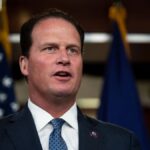

Washington unveiled its latest attempt at reviving its downtown with a plan to invest $400 million over five years to rethink existing spaces and invent new ones across different districts.
The 42-page plan revealed Monday lays out proposals to create new districts dedicated to education hubs, green space, and entertainment areas. The plan works in tandem with Mayor Muriel Bowser’s D.C. Comeback Plan, which she announced in January, setting down the five-year economic development plan for the city.
“With the future of Downtown, we have a unique opportunity — and responsibility — to be bold, creative, and collaborative,” Bowser wrote on X. “The Downtown Action Plan and Downtown Public Realm Plan give us a road map for how we can work together to deliver on the enormous potential of our Downtown.”
In the 1990s, the city received investments of more than $1 billion, adjusted to reflect 2024 dollars, that helped revitalize the city, supporting a new arena, the convention center, and a retail tax increment financing, or TIF, program. Thirty years later and a looming departure of the Washington Wizards and Capitals from Chinatown, Washington is looking to reimagine its downtown without the sports arena as an anchor.
“D.C. is at a unique turning point, and we have a plan to reposition the city better than ever before,” said Gerren Price, president and CEO of the DowntownDC BID. “With key investments from our partners, we’ll be able to create safer streets, support new and existing businesses, welcome new residents, and offer a vibrant 24/7 community that attracts everyone to our district.”
Annual tax revenue downtown has decreased by $243 million since 2019. Without intervention, the plan says annual tax revenue will fall an additional $193 million over the next five to 10 years. According to the plan, an investment of $401 million over the next five years is needed to counteract that, starting with a $39 million investment in 2025.
By creating optimal physical conditions, such as increased public safety and transportation, the city hopes that demand drivers such as offices, educational institutions, retail, and visitors will soon follow.
A road map to success, according to the city, is laid out via five foundational ideas: anchoring downtown’s comeback in public safety, creating a place of choice to locate and do business, creating a new residential base, planning for transportation as an asset to the area, and finally, “making it happen.”
“The plan recommends investments and actions to increase residents, draw in tourists, grow our tech ecosystem, establish cultural and entertainment corridors, attract universities and businesses, and cultivate an even more exciting and innovative place where people want to be,” said Leona Agouridis, president and CEO of the Golden Triangle BID.
The plan identifies five distinct geographic areas of downtown — Downtown East, Downtown West, Historic Green Triangle, Penn Quarter/Chinatown, and Penn West Equity, Innovation, and University District — and looks to ensure a curated approach to each area.
There are already concrete ideas laid out in the plan for areas of investment.
One proposal is to revamp the Farragut Square area directly north of the White House into a hub with a lush greenway for tourists to appreciate the civic importance of the area. The city also plans to piggyback off of existing redevelopment projects, such as the National Geographic redevelopment project, by adding other cultural and entertainment attractions into Downtown West.
CLICK HERE TO READ MORE FROM THE WASHINGTON EXAMINER
Looking to expand on George Washington University’s existing presence on Pennsylvania Avenue, the plan looks to attract other research and social science organizations to the Penn West Equity, Innovation, and University District.
The full version of the plan is scheduled for release in May.







